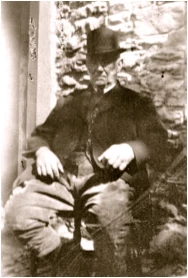Witch-bottles and healing charms
Bitten by a mad dog or cursed by a witch?
Ever wondered what you should do if you were bitten by a mad dog or cursed by a witch? In Wales it was a common practice, as late as the nineteenth and twentieth centuries in some parts, for people to use various kinds of charms for healing or protection against witchcraft. These could be in the form of prayer-like words, which were recited or written on a piece of paper to be safely hidden, while objects such as shoes or stones were also believed to cure illnesses and bring good luck.
Snakestones
Adder stones from Pen-tyrch, Glamorgan
The most renowned stone charms in Wales are the Maen Magl or Glain Nadredd — snakestones. In 1695 Edward Lhuyd described these as Cerrig y Drudion — Druid stones. The belief was that they were created when snakes joined their heads together, forming a kind of bubble about the head of one snake. This 'bubble' is similar to a glass ring like the one found at Twyn-y-tila, Caerleon, and was thought to bring good luck to whoever found it. It was also believed to be a remedy for eye diseases and was often in great demand. The term Maen signifies a stone and Magl is an ancient word for an eye ailment such as a stye. The water in which the stone had been soaked could be dabbed on the affected area, but the most common form of treatment involved rolling or rubbing the stone over the eyelid. People used to use the expression 'fel y glaim', literally 'like the stone', to mean very healthy.
A cure for rabies
Hydrophobia stone from Henllan, Ceredigion
The Llaethfaen or hydrophobia stone, thought to cure rabies, is a variant of the Maen Magl. In his Folk-Lore of West and Mid Wales, Jonathan Ceredig Davies wrote about a llaethfaen that was 'very much in request' because it was widely believed to cure those bitten by a mad dog, a common problem in the nineteenth century. Whether it had curative or preventative powers, those who used the stone were said to be safe from hydrophobia. Iolo Morgannwg described seeing a stone like this in Pembrokeshire in 1802, when he met a man who carried one around the country. He would scrape it into a powder which could be dissolved into a drink, and sell it for five shillings an ounce as a remedy for rabies.
Witch-bottles and pots
Now a witch bottle is a totally different kind of charm. Take this eighteenth- century Buckley pot, or witch-bottle, found buried at the foot of an old yew tree at Allt-y-Rhiw farmhouse near Llansilin, Powys. What is interesting about the jug is that a quarter if it was filled with lead. This suggests that it was used as some form of protection or, indeed, as a means of sealing or capturing a troublesome spirit, similar to the concealed shoes in our collection. Often with witchcraft beliefs the act of sealing an object within a bottle or pot symbolised the entrapment of the evil spirit, and so was used as a protective charm. There are many tales of troublesome ghosts being 'put down' in this way, like the ghost of 'Lady Jeffreys' who was persuaded to enter a bottle which was corked and sealed and thrown into the pool underneath the Short Bridge in Llanidloes.
Conjurers or dynion hysbys
When any bad luck occurred a conjurer was consulted to discover who had done the "witching", one such conjurer was Evan Griffiths from Pantybenni.
People who had been bewitched could also carry out their own counter-magic rituals by placing sharp objects like thorns and pins inside a bottle, which was usually filled with the victim's urine. It was then sealed and boiled over the fire or buried under the hearthstone. This was believed to torment the witch into revealing her identity, thereby breaking the spell. The bottle symbolised the witch's bladder, and so the sharp objects were believed to cause her much pain. Alternatively, you could buy a charm from a dyn hysbys — wise man. These figures were very common in Wales at one time, and their services ranged from countering witchcraft, healing, and astrology, to fortune telling and uncovering lost property.
In the nineteenth and early twentieth centuries Llangurig was especially famous for its dynion hysbys. Charms against witchcraft were written on a piece of paper which was carefully rolled up and sealed inside a bottle. This was then placed under the hearth or hidden in one of the main beams in the house, thus ensuring protection from witchcraft and any other evildoer. Should you find one of these charms, as with the concealed garments, remember to take photographs and record the details of exactly where you found it, and contact your local museum. Whatever you do, mind, always remember to keep the bottle sealed!



Comments - (3)
OLVOED YOUR ARTICLES
THANKS